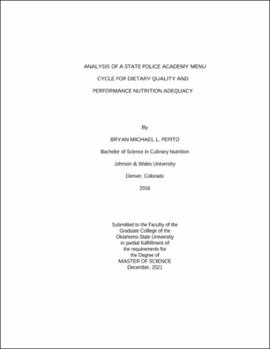| dc.contributor.advisor | Joyce, Jill | |
| dc.contributor.author | Pepito, Bryan Michael L. | |
| dc.date.accessioned | 2022-05-13T19:05:19Z | |
| dc.date.available | 2022-05-13T19:05:19Z | |
| dc.date.issued | 2021-12 | |
| dc.identifier.uri | https://hdl.handle.net/11244/335785 | |
| dc.description.abstract | Background: Law enforcement officers have high rates of overweight and obesity. With diet as a leading risk factor, early career nutrition interventions could be beneficial for establishing long-term healthy eating habits. Training academies present as an early career intervention opportunity. Thus, the purpose was to determine the diet quality (DQ) and performance nutrition adequacy of a state police academy's cafeteria menu. | |
| dc.description.abstract | Methods: This cross-sectional content analysis included six weeks (three daily meals, Monday-Friday) of a state police academy menu. Nutrient content was determined by meeting with the dining facility manager, portioning menus, and gathering food specifications and then performing nutrient analysis. DQ was assessed using the Healthy Eating Index (HEI) 2015. Independent t-test and Cohen's d determined differences between menu nutrient content and performance nutrient needs. | |
| dc.description.abstract | Results: The total HEI score was 54. Subcomponent scores indicating adequacy included daily protein (4.97 out of 5) and whole fruits (4.77 out of 5). Seafood and plant proteins (0.33 out of 5), ratio of fatty acids (1.31 out of 5), and dairy scores (1.59 out of 10) were low. Total fruit (3.19 out of 5), whole grains (6.10 out of 10), total vegetable (3.77 out of 5), and dark greens and legumes (3.51 out of 5) scores could be improved. The menu met recommended intake for 13 of 19 nutrients investigated. Nutrients that did not meet adequacy were calories (% mean difference, needs - menu = 36.7%), carbohydrates (% mean difference = 52.3%), vitamins D (% mean difference = 82.5%) and E (% mean difference = 66.7%), magnesium (% mean difference = 44.1%), and potassium (% mean difference = 41.8%). | |
| dc.description.abstract | Conclusions: The academy menu leaves room for various improvements in DQ and shortfall nutrients. By focusing on increasing low subcategory scores, overall DQ of the menu will increase and could potentially make up for some inadequate nutrients. | |
| dc.format | application/pdf | |
| dc.language | en_US | |
| dc.rights | Copyright is held by the author who has granted the Oklahoma State University Library the non-exclusive right to share this material in its institutional repository. Contact Digital Library Services at lib-dls@okstate.edu or 405-744-9161 for the permission policy on the use, reproduction or distribution of this material. | |
| dc.title | Analysis of a state police academy menu cycle for dietary quality and performance nutrition adequacy | |
| dc.contributor.committeeMember | Dawes, Jay | |
| dc.contributor.committeeMember | Hildebrand, Deana | |
| osu.filename | Pepito_okstate_0664M_17225.pdf | |
| osu.accesstype | Open Access | |
| dc.type.genre | Thesis | |
| dc.type.material | Text | |
| dc.subject.keywords | diet quality | |
| dc.subject.keywords | healthy eating index | |
| dc.subject.keywords | law enforcement | |
| dc.subject.keywords | nutrition | |
| dc.subject.keywords | performance | |
| thesis.degree.discipline | Nutritional Sciences | |
| thesis.degree.grantor | Oklahoma State University | |
